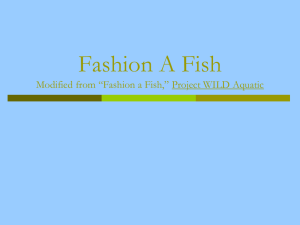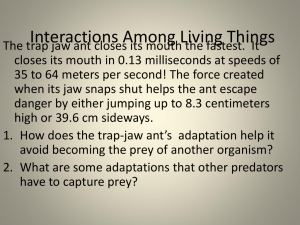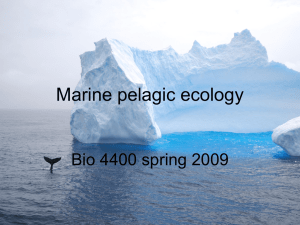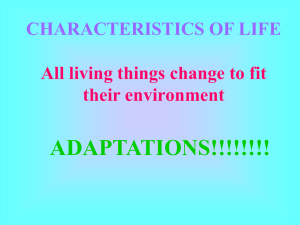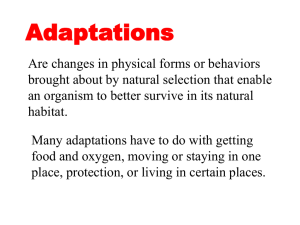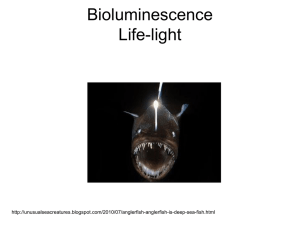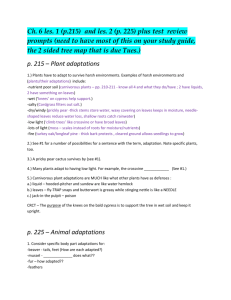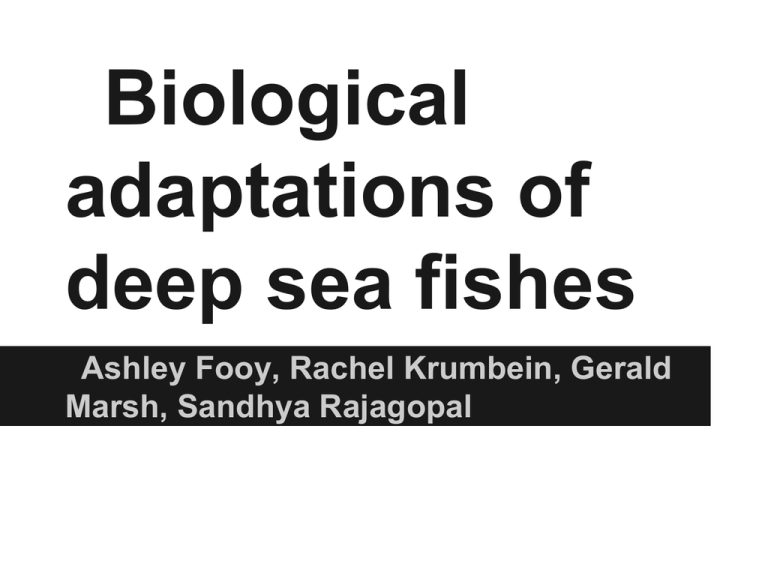
Biological
adaptations of
deep sea fishes
Ashley Fooy, Rachel Krumbein, Gerald
Marsh, Sandhya Rajagopal
Introduction
•
•
•
•
60% of the Earth's surface
Boundaries; part of the
ocean that spans beyond
the continental shelf
o Upper bound of 200m
lower 11,000m
Pressure; 1000x the
atmospheric pressure
Temperatures; -1C to 4C
Adaptations
•
High Pressures
o Reduced skeleton and
o
•
muscle mass
Piezolytes; prevent distortion
of molecules
Colder temperatures
o Flexible proteins and
unsaturated membranes
Adaptations (con't)
•
•
Food availability - limited
o Large mouth/jaw hinges,
teeth that hook inward, and
expandable stomachs
Reproduction
o Sexual parasitism
Bioluminescence
• 80% of deep sea
•
fishes
Photophores; light
emitting organs
Intrinsic; chemical
reactions under
neural/hormonal
control
o Extrinsic; symbiotic
relationship with
bioluminescent
bacteria under
mechanical control
o
Bioluminescence (Con't)
•
Usage
o
o
o
o
Attract/ startle prey
Confuse predators
Mimic light
traveling in a
different direction
Attracting a mate
Counterillumination
Use photophores
to match the light
radiating from the
environment
•
•
•
Velvet Belly Lantern Shark
Important ecological
role; one of the most
abundant predators
Captured/discarded by
several off-shore
fisheries
Nine luminous zones
(hormonal control)
o Counterillumination (produce
o
light to match an illuminated
background)
Cooperative
swimming/hunting and sex
signaling
Anglerfishes
•
Order Lophiiformes,
Suborder Ceratioidae
Anglerfishesbioluminescence
• Structure of escal
photophore
•
o
fluorescent bacteria
Purpose of escal
photophore
Anglerfishes - feeding and
locomotion
• lie-in-wait predator
interesting adaptation
when feeding on the
bottom
o diet
o
•
common locomotive
patterns
o
o
passive drifting
movement when
threatened
Anglerfishes reproduction
•
two reproductive
strategies
o
o
•
Male anglerfish larva
fusion
temporary
attachment
sexual dimorphism
Deep-sea hatchetfish
•
•
Argyropelecus affinis or
Argyropelecus
hemigymnus
Adaptations
o Upward facing snout,
mouth
o Upward facing, large,
tubular eyes
o Narrow silhouettes,
silver sides
Deep-sea hatchetfish
•
•
Bioluminescence
o Camouflage,
counterillumination
o Can rapidly alter
luminescence
according to
background
o Possible nitric oxide
modulation of
luminescence
Zooplanktivorous
•
•
Lens pigmentation
o Increased acuity
o Detect own group
o Avoid enemies
o Chemical properties
differ from other
species with coloration
Sexual dimorphism in
olfactory organs
o Males larger than
females
o Pheromone responses
Umbrella Mouth Gulper
eel
Adaptations: Pelican eel
Enlarged mouth & head
o "Largest gape size of any
•
Saccopharyngiformes
Eurypharynx pelecanoides
•
•
•
vertebrate in relation to body
size" (Nielsen, 1989 p.194).
Extended lateral line
Luminous filaments on
caudal fin used for
hunting
Leptocephalic Larve
o Similar to relatives they
breed once and die
(semelparity)
Umbrella mouth Gulper
eel
Ambush hunting
•
•
•
Lure hunting
Uses lateral line to detect prey
Lunges at prey using water to
open mouth similar to a
parachute
o Only has to expend energy
closing jaw
Typically used when hunting
small prey
•
•
•
Ambush hunting of larger prey
items
Bioluminescent filaments on
caudal fin are used to lure prey
closer
Before they swallow prey they
digest it in its gape with an acidic
substrate.
Conservation
•
•
Largest ecosystem with
least know about it
o Millions of square miles of
unexplored ocean floor
Possibly the largest
reservoir of biomass on
the planet
o Number of species living
there may outnumber
terrestrial animals
•
•
Millions of years of evolution in a
harsh environment requires very
specialized adaptations
Practical uses of fish adaptations
for developing medicine
Conservation
Environmental changes
•
•
"Undetected mass extinctions"
So few interactions with them we
have no idea if populations are
declining
Human impacts
•
•
Deep ocean oil spills
o Event horizon spill
Overfishing of top predators &
fishing down the food web
Conservation is important because the
benefits these fish can provide is highly
unknown
Conclusion and future
directions
• more research is
•
•
needed for all
species
new technology
biological
adaptations are key
to success in the
deep sea

